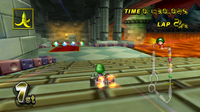Mini-Turbo
The Mini-Turbo is a term used in the Mario Kart series, it consists in a brief boost of speed following a drift or skidding. It appears in every game in the series since Super Mario Kart. Usually, players tend to manage several consecutive Mini-Turbos to accelerate faster. In some games, it can also be executed on straight stretches of track, if the stretch is long enough. When this happens, the player tends to go to both sides of the track in a wavy or snake-like pattern. This is known as a "Straight-Stretch Mini-Turbo", or, more commonly, "Snaking".
Main kinds of Mini-Turbos throughout the series
Super Mario Kart and Mario Kart: Super Circuit: straight after long drift
In Super Mario Kart and Mario Kart:Super Circuit Mini-Turbos are normally charged by drifting for a certain amount of time (usually more than a second) and released by returning straight.
In Super Mario Kart Mini-Turbos are usually known as boosts and their release is recognizable by the sound of the engine becoming more acute for about a second. No animation is associated both to the charging and to the release.
In Mario Kart: Super Circuit, there is no animation associated to the charging of the Mini-Turbo, but there is a small animation related to the release, with blue sparks coming from the engine, along with a sound effect.
Mario Kart 64, Mario Kart: Double Dash!! and Mario Kart DS: manual charging
In Mario Kart 64, Mario Kart: Double Dash!! and Mario Kart DS, the Mini-Turbo is charged manually while drifting by steering in the direction opposite of the turn and then in the direction of the turn while drifting. It is necessary to charge this way the Mini-Turbo two times, although in some cases it may not be necessary to steer in the direction of the turn the second time. It is released by releasing the drift button.
In Mario Kart 64 the charging is denoted by a change in the colour of the letters that come out from the Kart, from white to yellow to indicate an half charge and from yellow to red to indicate a full charge. The release has no animation associated and is denoted by drivers speaking.
In Mario Kart: Double Dash!! the charging is indicated by a change in the colour of the sparks coming from the wheels of the kart from yellow to orange and then blue, and a small animation is associated to the release, with fire coming from the exhaust pipes and small yellow sparks coming from the wheels, along with a sound effect and a call by the driver who is behind. In co-op, the player who is driving must press the ![]() or
or ![]() button to drift while the back player must tilt the Control Stick to left and right; however, in single-player or non-co-op VS modes, each player controls both parts.
button to drift while the back player must tilt the Control Stick to left and right; however, in single-player or non-co-op VS modes, each player controls both parts.
In Mario Kart DS the charging animation is similar, with sparks appearing with half charge as blue and then becoming orange with a full charge. There is no evident animation following the release, but a small sound is associated with it along with a revving up of the engine.
Mario Kart Wii, Mario Kart 7 and Mario Kart 8: time-based charging
Since Mario Kart Wii, the Mini-Turbo is charged after a certain time has passed while drifting and released by releasing the drift button.
The time can be reduced by tilting the control stick or pushing the D-Pad in the direction of the drifting, and is increased if the Control Stick is tilted or the D-Pad is pushed in the direction opposite to the drift. The charging of the Mini-Turbo is indicated by blue sparks coming from the wheels and its release is denoted by fire coming from the exhaust pipes along with an associated sound and the driver speaking. Karts can further charge a Super Mini-Turbo that lasts twice as long and whose charging is indicated by yellow or orange sparks coming from the wheels. Each vehicle is given a different Mini-Turbo rating. This affects how strong the vehicle's Mini-Turbo will be. As an example, in Mario Kart Wii the Bullet Bike has the best Mini-Turbo, while the Jetsetter has the worst. The drivers too have a Mini-Turbo rating, as well as vehicle parts in Mario Kart 7 and Mario Kart 8.
In Mario Kart Wii a Mini-Turbo can be charged while standing still by holding both the jump/brake button and the acceleration button at the same time. Karts in this case only charge a regular Mini-Turbo and not a Super Mini-Turbo. This kind of Mini-Turbo is released immediately when the brake/jump button is no longer pressed.
In Mario Kart 8 all vehicles are able to charge a Super Mini-Turbo. Furthermore, a Super Mini-Turbo can be charged by skidding as a consequence of tight steering, although in this case the time needed is almost doubled both for the regular and Super Mini-Turbo. This special kind of Mini-Turbo is immediately released when the steering ends.
